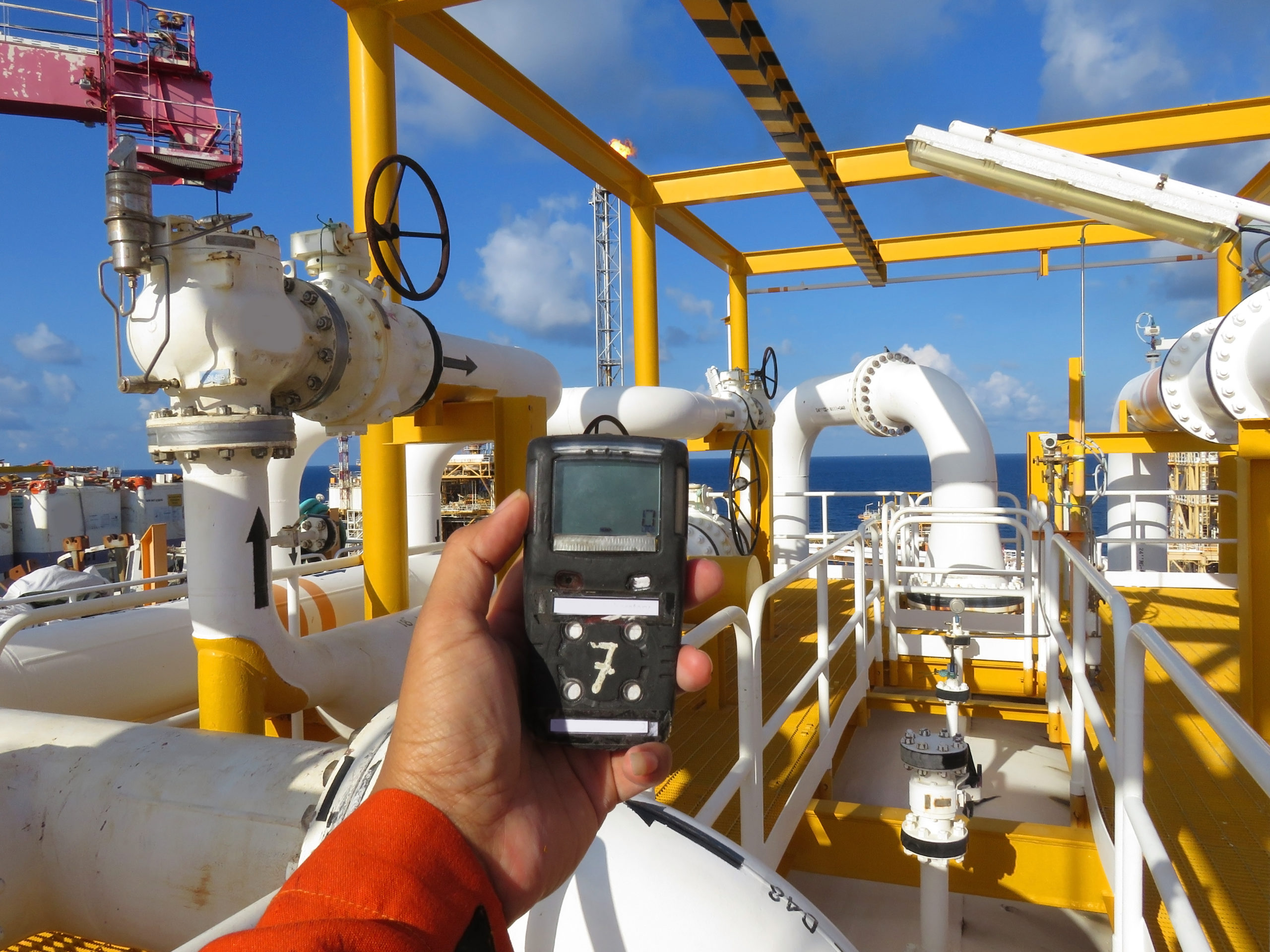H2S Removal Using Scavengers
Posted on June 14th, 2021
Posted in Uncategorized

H2S is a well known, highly toxic contaminant that is found in some oil and gas production. Most H2S migrates to the gas, and removal is necessary to achieve sales gas pipeline specifications, or SO2 emissions limits. For applications with low levels of sulfur, the optimum method for removal is not always obvious. Owners often default to what is most familiar or most commonly applied, without considering other options available.
Scavengers offer a non-regenerable H2S treatment option that is typically reserved for applications with <500 lb/day of H2S, as operating costs and sometimes logistics often become impractical beyond this point. However, the economics of treating with scavengers are directly related to the sales price of gas and oil, the price of the scavenger, and whether the application is temporary or more permanent in nature.
There are both solid and liquid scavengers, both of which have their own advantages and disadvantages.
Liquid scavengers
While there are many liquid scavengers available, triazine is the most commonly used chemical for H2S removal. Controlled contact between triazine-based liquid scavengers and H2S is critical because excessive contact or high H2S concentrations can lead to saturation with dithiazine and precipitation. Solids formation is the most significant problem associated with the use of liquid scavengers.
Contact can be achieved in a variety to configurations. Less sophisticated contact mechanisms such as direct injection or static mixers are more likely to lead to chemical overuse and therefore higher operating costs and likelihood of plugging. Other more complex contact configurations such as batch contact towers or flooded tower systems allow better control of chemical use, though capital costs are higher.
Triazine based liquid scavengers do not react with CO2 therefore its presence does not negatively impact scavenging efficiency. Many formulations can partially remove light mercaptans (methyl, ethyl and propyl).
Solids formation and chemical overuse are the most notable problems associated with the use of liquid scavengers. Spent triazine solutions also have a very strong odor.
Caustic is another well known liquid scavenger. The challenge with caustic is that CO2 is also readily scrubbed by caustic, and conventional designs will generally scrub/remove most of the CO2 along with the H2S. The reaction of caustic with H2S is faster than that with CO2, so selective systems can be designed. In all cases, close attention much be paid to the solubility of the salts formed in the reactions with caustic. The composition of the salts is dependent on the presence of CO2, caustic strength, and solution pH.
Solid scavengers
The most inexpensive solid absorbents are based on iron chemistry. The oldest commercial form of this treatment is called iron sponge, which uses wood chips as a support material. One of the primary concerns about iron sponge was that the spent material is pyrophoric. This led to the development of many other iron-based solid scavengers that had a different substrate, which renders the spent material non-pyrophoric, amongst other improvements. There are now products offered that have no support material at all, which reduces the amount of material needed for treatment.
One of the primary concerns amongst users is related to the tendency of iron-based scavengers to agglomerate in the vessels over a period of time, making change outs labor intensive. Another limiting characteristic is that nearly all iron-based solid scavengers require the gas to be saturated with water, or at least have some water content; i.e., they cannot treat dry gas. Halker is aware of one iron-based product that claims to be able to treat dry gas, with the possible trade-off of reduced life.
There are also solid scavengers based on zinc oxide, copper oxide and mixed metal oxides. These solid scavengers do not rely on the presence of water, but they are also more expensive than iron-based absorbents and are therefore best suited for special cases, such as when the gas requiring treatment is dry or needs to be treated down to extremely low levels of H2S. In some applications with zinc oxide, it is possible to send the spent material to a smelter to recover the zinc and thereby reduce or eliminate disposal costs. Some copper oxide scavengers can be designed for simultaneous removal of H2S and mercury.
Finally, activated carbon can be used for H2S removal, though its application is typically limited to non-hydrocarbon streams because it will also remove hydrocarbons from gas streams.
If you would like to explore your options for H2S removal, our experts welcome the opportunity to to help you find the very best solution for your site.
 Curtis Anderson is a seasoned Projects Director at Halker, specializing in managing projects for electric utilities and renewable energy companies, including high voltage power, solar, wind, and battery energy storage systems (BESS). Prior to his current role, Curtis held various leadership positions with 12 years in the industry. As Technology Innovation Manager, he was instrumental in establishing and leading a Product and Innovation team within the Power and Renewables Industry, driving technology enablement initiatives, and fostering a culture of innovation. His work included guiding the development of new products, implementing AI-driven solutions, and supporting the launch of industry-first SaaS offerings. Curtis also played a key role in business-to-business collaborations, strategic planning, and served as a member of an Artificial Intelligence Governance Board, focusing on enhancing operational efficiency through technology and R&D efforts.
Curtis Anderson is a seasoned Projects Director at Halker, specializing in managing projects for electric utilities and renewable energy companies, including high voltage power, solar, wind, and battery energy storage systems (BESS). Prior to his current role, Curtis held various leadership positions with 12 years in the industry. As Technology Innovation Manager, he was instrumental in establishing and leading a Product and Innovation team within the Power and Renewables Industry, driving technology enablement initiatives, and fostering a culture of innovation. His work included guiding the development of new products, implementing AI-driven solutions, and supporting the launch of industry-first SaaS offerings. Curtis also played a key role in business-to-business collaborations, strategic planning, and served as a member of an Artificial Intelligence Governance Board, focusing on enhancing operational efficiency through technology and R&D efforts. Shannon McKibben is the director of Environmental Engineering at Halker, executing environmental, health, and safety projects for clients in construction, oil & gas, transportation, and power delivery. Under Shannon’s leadership, Halker’s Environmental Engineering group is actively diversifying from its historical role serving primarily road and highway construction clients into a support group for all of Halker’s projects, focusing on energy delivery and development.
Shannon McKibben is the director of Environmental Engineering at Halker, executing environmental, health, and safety projects for clients in construction, oil & gas, transportation, and power delivery. Under Shannon’s leadership, Halker’s Environmental Engineering group is actively diversifying from its historical role serving primarily road and highway construction clients into a support group for all of Halker’s projects, focusing on energy delivery and development. Dominic brings over 15 years of leadership in privately held and PE‑backed firms. Dominic’s experience in the energy industry expands across several sectors, including refining, midstream & pipeline and delivering fully modular facility solutions in the upstream production arena. Dominic has been involved in the sales and project management of more than 30 fully modular facilities in the Permian basin. He has built scalable go‑to‑market strategies that have helped drive impressive revenue growth: from $10M to $25M at Welker, and launching Petrosmith’s Modflex line to $40M in three years, while more than doubling revenue with its largest client.
Dominic brings over 15 years of leadership in privately held and PE‑backed firms. Dominic’s experience in the energy industry expands across several sectors, including refining, midstream & pipeline and delivering fully modular facility solutions in the upstream production arena. Dominic has been involved in the sales and project management of more than 30 fully modular facilities in the Permian basin. He has built scalable go‑to‑market strategies that have helped drive impressive revenue growth: from $10M to $25M at Welker, and launching Petrosmith’s Modflex line to $40M in three years, while more than doubling revenue with its largest client. 




 Philip Barr joined Halker in April 2023. With nearly 20 years of structural engineering experience, he has contributed to projects across the oil and gas, pharmaceutical, chemical, mining and metals, and manufacturing industries. Philip has successfully led structural design teams in executing projects totaling over one billion dollars in value. He has also worked internationally as a field engineer and client representative, gaining valuable experience in constructability, modular design, and retrofit construction. As Halker’s Director of Structural Engineering, Philip draws on his extensive background and technical expertise to deliver innovative and cost-effective structural solutions for clients across a wide range of industries.
Philip Barr joined Halker in April 2023. With nearly 20 years of structural engineering experience, he has contributed to projects across the oil and gas, pharmaceutical, chemical, mining and metals, and manufacturing industries. Philip has successfully led structural design teams in executing projects totaling over one billion dollars in value. He has also worked internationally as a field engineer and client representative, gaining valuable experience in constructability, modular design, and retrofit construction. As Halker’s Director of Structural Engineering, Philip draws on his extensive background and technical expertise to deliver innovative and cost-effective structural solutions for clients across a wide range of industries.
 Cory Shattuck is the Vice President of Power Services at Halker, based in Centennial, Colorado. With a career spanning roles such as Director of Power Delivery, Utility-scale Solar Technical Manager, Substation Technical Manager, and various engineering positions, Cory brings a wealth of experience to the energy sector. Cory’s expertise includes substation design, medium-voltage underground collection systems, electrical studies, and relay settings. In his current role, he leads the Power Services division, overseeing project execution, technical excellence, and strategic growth. His leadership is grounded in a commitment to quality, safety, and innovation in power delivery solutions. He has served as a Quality Manager for a key client and contributed to both Quality and Safety Committees. Cory holds a Bachelor of Science in Electrical Engineering from the South Dakota School of Mines and a Master of Business Administration from Colorado State University. He is also a licensed Professional Engineer.
Cory Shattuck is the Vice President of Power Services at Halker, based in Centennial, Colorado. With a career spanning roles such as Director of Power Delivery, Utility-scale Solar Technical Manager, Substation Technical Manager, and various engineering positions, Cory brings a wealth of experience to the energy sector. Cory’s expertise includes substation design, medium-voltage underground collection systems, electrical studies, and relay settings. In his current role, he leads the Power Services division, overseeing project execution, technical excellence, and strategic growth. His leadership is grounded in a commitment to quality, safety, and innovation in power delivery solutions. He has served as a Quality Manager for a key client and contributed to both Quality and Safety Committees. Cory holds a Bachelor of Science in Electrical Engineering from the South Dakota School of Mines and a Master of Business Administration from Colorado State University. He is also a licensed Professional Engineer.



